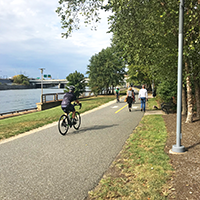
November 10, 2022
A new analysis examines how the COVID-19 pandemic has affected bicycle and pedestrian traffic in two areas of Philadelphia. Using data collected from the intersection of Front and Chestnut streets and the Schuylkill River Trail near the Walnut Street Bridge, the analysis compares pre-pandemic usage from March 2019 to March 2020, to usage in July 2021 to July 2022, when some residents began to resume normal activities despite COVID-19’s lingering presence.
The COVID-19 pandemic transformed nearly all aspects of society. This analysis examines its impact on pedestrian and bicycle traffic along two segments in the City of Philadelphia: Front and Chestnut Streets, which have an automatic pedestrian counter, and the Schuylkill River Trail near the Walnut Street Bridge, which has a pedestrian and bicycle counter. The two time periods evaluated were pre-pandemic, from March 2019 to March 2020, and July 2021 to July 2022, when some residents began resuming normal activities despite COVID-19’s lingering presence.
As seen in table 1 below, there has been a slow but steady increase of pedestrian traffic at Front and Chestnut relative to 2019 figures. Pedestrian volumes were down 7%, but this represents a significant uptick from 2021 when they were down as much as 40%. Along the Schuylkill River Trail, pedestrian traffic has returned to pre-pandemic levels but bicycle volumes were down 34%. In the first half of 2021, there was an abrupt decline in pedestrian and bicycle traffic as this section of the Trail was closed from February to July due to the reconstruction of the Chestnut Street Bridge (the data reviewed for this analysis is from before and after the closure). Additionally, MLK Drive, a popular bicycle connection to the Schuylkill River Trail that had been closed to motorists beginning in March of 2020, re-opened to car traffic north of Sweetbriar Drive in August of 2021. The re-opening of MLK Drive and the residual impact of the trail closure may have contributed to the decline of bicyclists on the Schuylkill River Trail.
Figure 1
| Pedestrian and Bicycle Traffic - 2019 vs. 2021/2022 | |||||||
| Year | Month | Front & Chestnut (ped - % change vs. 2019) | Front & Chestnut (ped - absolute change vs. 2019) | Schuylkill Banks (ped - % change vs. 2019) | Schuylkill Banks (ped - absolute change vs. 2019) | Schuylkill Banks (cyclists - % change vs. 2019) | Schuylkill Banks (cyclists - absolute change vs. 2019) |
| 2021 | Q1 - January to March** | - | - | -3% | -85** | -36% | -245** |
| Q2 - April to June** | -40% | -1472 | -36% | -1564** | -81% | -1611** | |
| Q3 - July to September | -10% | -301 | -15% | -507 | -22% | -464 | |
| Q4 - October to December | -30% | -1106 | 9% | +247 | 3% | +26 | |
| 2022 | Q1 - January to March | - | - | 6% | +161 | -21% | -143 |
| Q2 - April to June | -7% | -268 | -2% | -75 | -34% | -682 | |
| *Data only available beginning March 26th, 2019 **Chestnut St bridge under construction, portion of Schuylkill Banks closed | Source: Eco-Counters (2019 - 2022) | ||||||
As pedestrian traffic returned to Front and Chestnut, there was a significant shift in activity by time of day. As displayed in figures 2 and 3 below, there was a pronounced decrease in weekday pedestrian traffic during traditional lunch hours, typically from 11:30 am to 1:30 pm. This may be due to the ongoing prevalence of telecommuting as well as businesses reducing hours, such as restaurants pivoting to only offering dinner service due to labor shortages. Pedestrian traffic on Friday and Saturday evenings was still well below its 2019 levels but experienced a rebound, while Sunday volumes increased dramatically throughout the day, especially in the mid-afternoon.
Figure 2
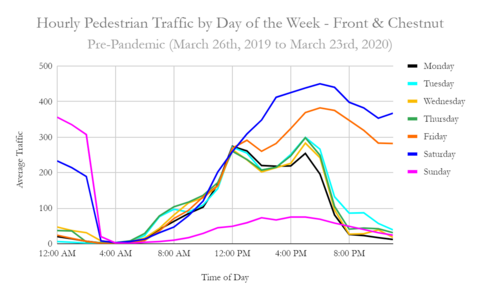
Figure 3
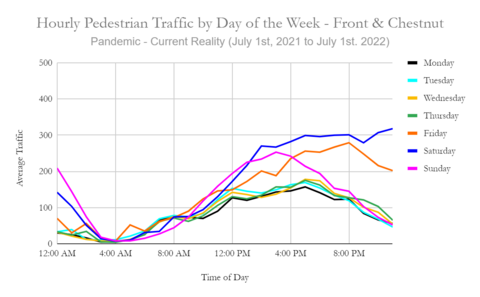
On the Schuylkill River Trail, pedestrian traffic from July 2021 to July 2022 generally mirrors patterns seen before the COVID-19 pandemic, while bicycle volumes were notably lower. As displayed in figures 4 and 5, bicycle traffic for each time period has a similar pattern throughout the day, but from July 2021 to July 2022 the volumes were much lower for each day of the week. Relative to the year before the pandemic, there were significantly fewer cyclists during the weekday morning rush hour, typically from 7:00 am to 9:00 am. This may be in part due to an increase in cyclists telecommuting as opposed to commuting on the Trail. While bicycle traffic was also down during the evening rush hour, it was much closer to its pre-pandemic level, which may indicate that recreational cyclists are filling the absence of former commuters.
Figure 4
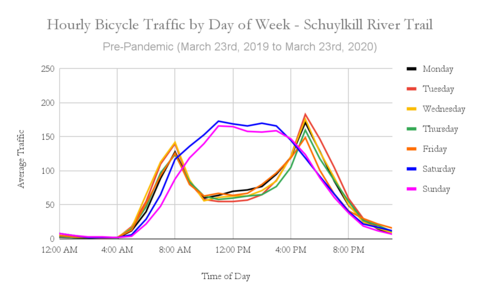
Figure 5
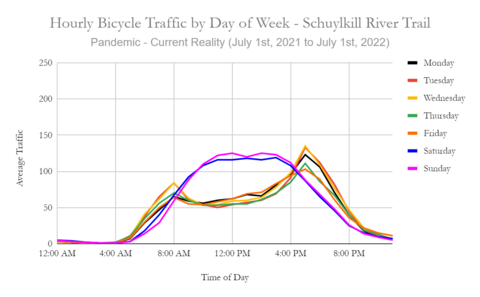
The rebound of pedestrian traffic at Front and Chestnut suggests an important return of economic activity to the corridor and is a promising sign for other commercial districts around the City. The route’s activity patterns have shifted throughout the week, showing a decline during weekday lunch hours and an increase in Sunday afternoon traffic. On the Schuylkill River Trail, the decrease of bicycle volumes, especially compared to the complete rebound among pedestrians, suggests a behavioral change among cyclists. Along with the prevalence of telecommuting, the re-opening of MLK Drive to motorists, and the closure of the Chestnut Street Bridge, other factors that may be contributing to depressed bicycle volumes might include inclement weather, new COVID-19 variants and case counts, an uptick in out of town travel, or cyclists choosing other bike routes, such as the increasingly popular Delaware River Trail or the protected bike lanes on 22nd Street. For Front & Chestnut and the Schuylkill River Trail, along with many other locations through the City, future analysis is needed to determine whether the COVID-19 pandemic has permanently or just temporarily changed pedestrian and bicycle behavior in Philadelphia.